Contract Law Analysis: Breaches, Remedies, and Case Study Examples
VerifiedAdded on 2020/04/01
|8
|2134
|70
Homework Assignment
AI Summary
This assignment delves into the fundamentals of contract law, focusing on breach of contract scenarios through detailed case studies. The first case examines the issues between Ian and Ben, exploring the formation of a contract through email correspondence and the consequences of a potential breach when an invitation for an astronomy class was not properly received. The second case analyzes the situation between Sharon and Ben, considering whether a contract was formed and if a breach occurred due to misinterpretations related to expertise listings. Finally, the assignment addresses a third case involving Gordon, Mary, and Cheng, analyzing a car sale and potential fraudulent activities, including breach of contract and the legal remedies available to Gordon. The assignment references relevant legal principles, applications, and outcomes, supported by academic references.
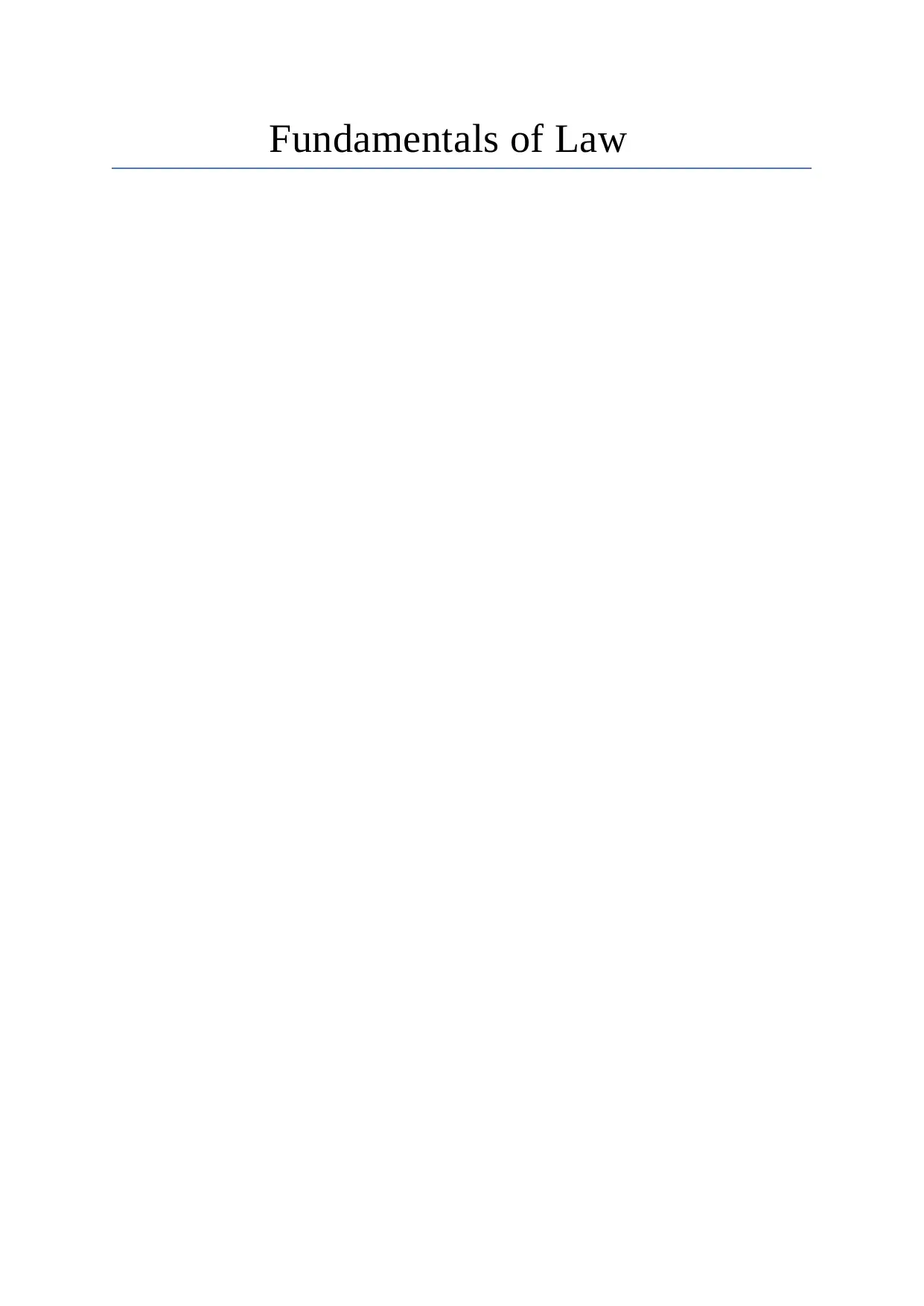
Fundamentals of Law
Paraphrase This Document
Need a fresh take? Get an instant paraphrase of this document with our AI Paraphraser
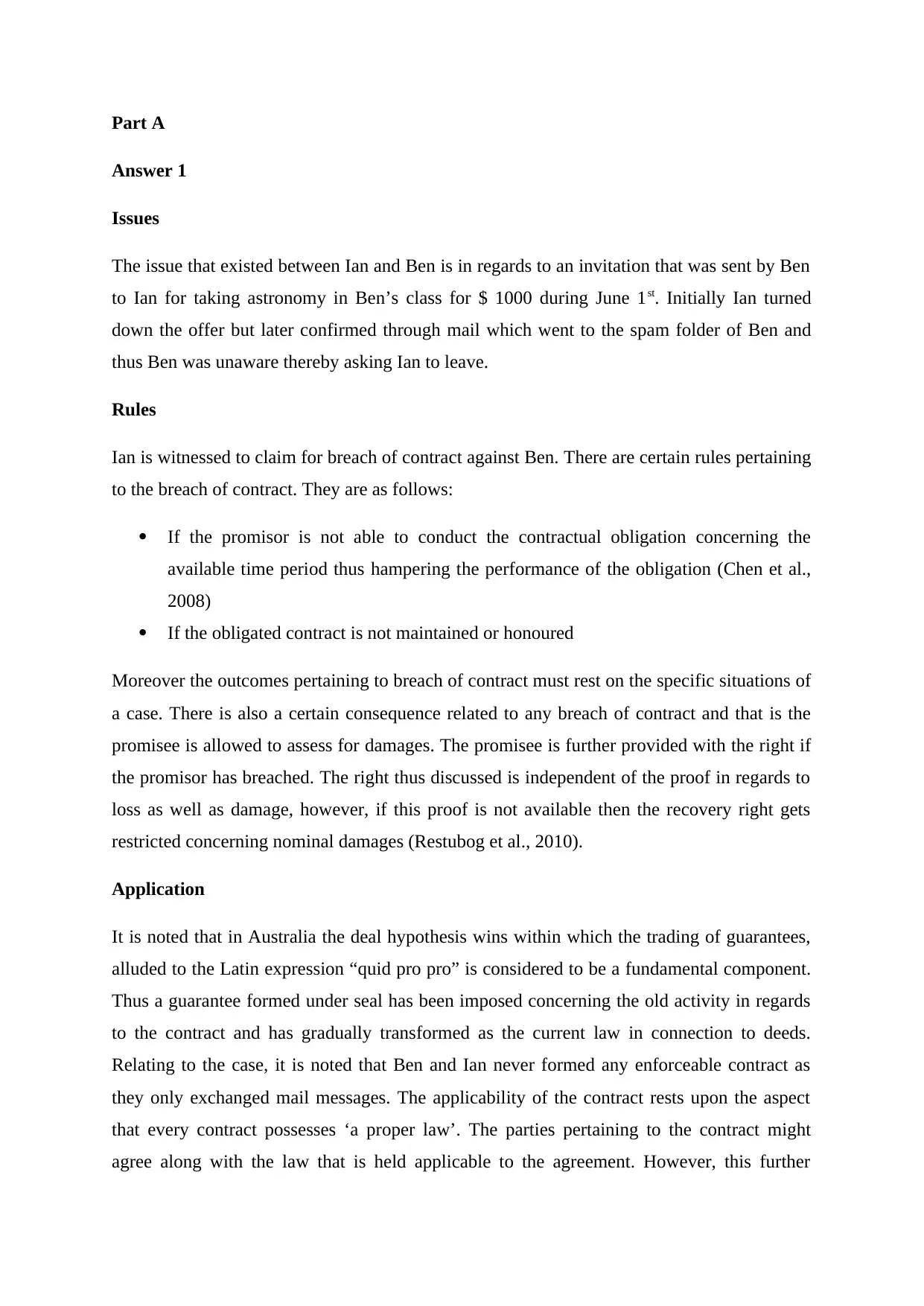
Part A
Answer 1
Issues
The issue that existed between Ian and Ben is in regards to an invitation that was sent by Ben
to Ian for taking astronomy in Ben’s class for $ 1000 during June 1st. Initially Ian turned
down the offer but later confirmed through mail which went to the spam folder of Ben and
thus Ben was unaware thereby asking Ian to leave.
Rules
Ian is witnessed to claim for breach of contract against Ben. There are certain rules pertaining
to the breach of contract. They are as follows:
If the promisor is not able to conduct the contractual obligation concerning the
available time period thus hampering the performance of the obligation (Chen et al.,
2008)
If the obligated contract is not maintained or honoured
Moreover the outcomes pertaining to breach of contract must rest on the specific situations of
a case. There is also a certain consequence related to any breach of contract and that is the
promisee is allowed to assess for damages. The promisee is further provided with the right if
the promisor has breached. The right thus discussed is independent of the proof in regards to
loss as well as damage, however, if this proof is not available then the recovery right gets
restricted concerning nominal damages (Restubog et al., 2010).
Application
It is noted that in Australia the deal hypothesis wins within which the trading of guarantees,
alluded to the Latin expression “quid pro pro” is considered to be a fundamental component.
Thus a guarantee formed under seal has been imposed concerning the old activity in regards
to the contract and has gradually transformed as the current law in connection to deeds.
Relating to the case, it is noted that Ben and Ian never formed any enforceable contract as
they only exchanged mail messages. The applicability of the contract rests upon the aspect
that every contract possesses ‘a proper law’. The parties pertaining to the contract might
agree along with the law that is held applicable to the agreement. However, this further
Answer 1
Issues
The issue that existed between Ian and Ben is in regards to an invitation that was sent by Ben
to Ian for taking astronomy in Ben’s class for $ 1000 during June 1st. Initially Ian turned
down the offer but later confirmed through mail which went to the spam folder of Ben and
thus Ben was unaware thereby asking Ian to leave.
Rules
Ian is witnessed to claim for breach of contract against Ben. There are certain rules pertaining
to the breach of contract. They are as follows:
If the promisor is not able to conduct the contractual obligation concerning the
available time period thus hampering the performance of the obligation (Chen et al.,
2008)
If the obligated contract is not maintained or honoured
Moreover the outcomes pertaining to breach of contract must rest on the specific situations of
a case. There is also a certain consequence related to any breach of contract and that is the
promisee is allowed to assess for damages. The promisee is further provided with the right if
the promisor has breached. The right thus discussed is independent of the proof in regards to
loss as well as damage, however, if this proof is not available then the recovery right gets
restricted concerning nominal damages (Restubog et al., 2010).
Application
It is noted that in Australia the deal hypothesis wins within which the trading of guarantees,
alluded to the Latin expression “quid pro pro” is considered to be a fundamental component.
Thus a guarantee formed under seal has been imposed concerning the old activity in regards
to the contract and has gradually transformed as the current law in connection to deeds.
Relating to the case, it is noted that Ben and Ian never formed any enforceable contract as
they only exchanged mail messages. The applicability of the contract rests upon the aspect
that every contract possesses ‘a proper law’. The parties pertaining to the contract might
agree along with the law that is held applicable to the agreement. However, this further
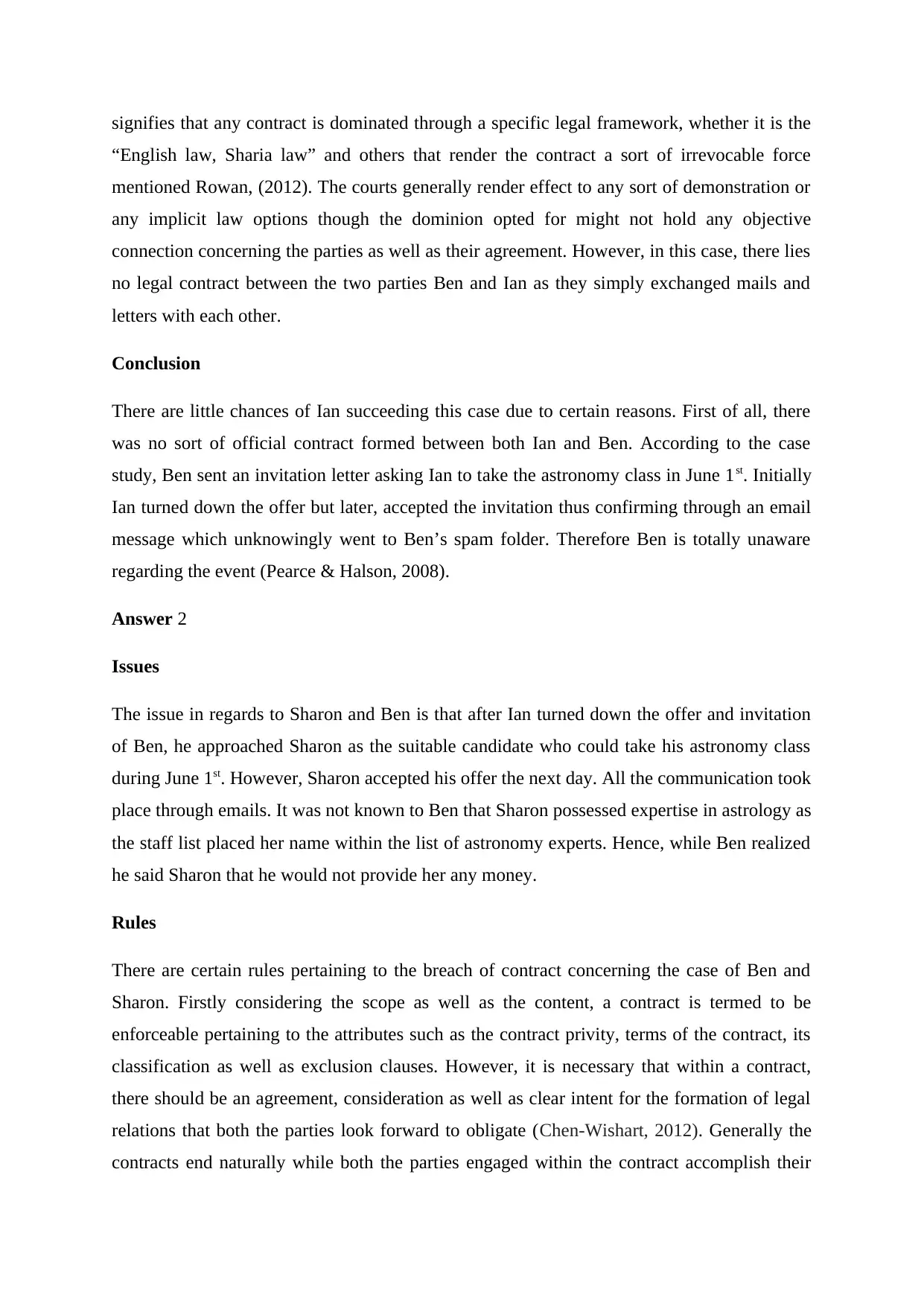
signifies that any contract is dominated through a specific legal framework, whether it is the
“English law, Sharia law” and others that render the contract a sort of irrevocable force
mentioned Rowan, (2012). The courts generally render effect to any sort of demonstration or
any implicit law options though the dominion opted for might not hold any objective
connection concerning the parties as well as their agreement. However, in this case, there lies
no legal contract between the two parties Ben and Ian as they simply exchanged mails and
letters with each other.
Conclusion
There are little chances of Ian succeeding this case due to certain reasons. First of all, there
was no sort of official contract formed between both Ian and Ben. According to the case
study, Ben sent an invitation letter asking Ian to take the astronomy class in June 1st. Initially
Ian turned down the offer but later, accepted the invitation thus confirming through an email
message which unknowingly went to Ben’s spam folder. Therefore Ben is totally unaware
regarding the event (Pearce & Halson, 2008).
Answer 2
Issues
The issue in regards to Sharon and Ben is that after Ian turned down the offer and invitation
of Ben, he approached Sharon as the suitable candidate who could take his astronomy class
during June 1st. However, Sharon accepted his offer the next day. All the communication took
place through emails. It was not known to Ben that Sharon possessed expertise in astrology as
the staff list placed her name within the list of astronomy experts. Hence, while Ben realized
he said Sharon that he would not provide her any money.
Rules
There are certain rules pertaining to the breach of contract concerning the case of Ben and
Sharon. Firstly considering the scope as well as the content, a contract is termed to be
enforceable pertaining to the attributes such as the contract privity, terms of the contract, its
classification as well as exclusion clauses. However, it is necessary that within a contract,
there should be an agreement, consideration as well as clear intent for the formation of legal
relations that both the parties look forward to obligate (Chen-Wishart, 2012). Generally the
contracts end naturally while both the parties engaged within the contract accomplish their
“English law, Sharia law” and others that render the contract a sort of irrevocable force
mentioned Rowan, (2012). The courts generally render effect to any sort of demonstration or
any implicit law options though the dominion opted for might not hold any objective
connection concerning the parties as well as their agreement. However, in this case, there lies
no legal contract between the two parties Ben and Ian as they simply exchanged mails and
letters with each other.
Conclusion
There are little chances of Ian succeeding this case due to certain reasons. First of all, there
was no sort of official contract formed between both Ian and Ben. According to the case
study, Ben sent an invitation letter asking Ian to take the astronomy class in June 1st. Initially
Ian turned down the offer but later, accepted the invitation thus confirming through an email
message which unknowingly went to Ben’s spam folder. Therefore Ben is totally unaware
regarding the event (Pearce & Halson, 2008).
Answer 2
Issues
The issue in regards to Sharon and Ben is that after Ian turned down the offer and invitation
of Ben, he approached Sharon as the suitable candidate who could take his astronomy class
during June 1st. However, Sharon accepted his offer the next day. All the communication took
place through emails. It was not known to Ben that Sharon possessed expertise in astrology as
the staff list placed her name within the list of astronomy experts. Hence, while Ben realized
he said Sharon that he would not provide her any money.
Rules
There are certain rules pertaining to the breach of contract concerning the case of Ben and
Sharon. Firstly considering the scope as well as the content, a contract is termed to be
enforceable pertaining to the attributes such as the contract privity, terms of the contract, its
classification as well as exclusion clauses. However, it is necessary that within a contract,
there should be an agreement, consideration as well as clear intent for the formation of legal
relations that both the parties look forward to obligate (Chen-Wishart, 2012). Generally the
contracts end naturally while both the parties engaged within the contract accomplish their
⊘ This is a preview!⊘
Do you want full access?
Subscribe today to unlock all pages.

Trusted by 1+ million students worldwide
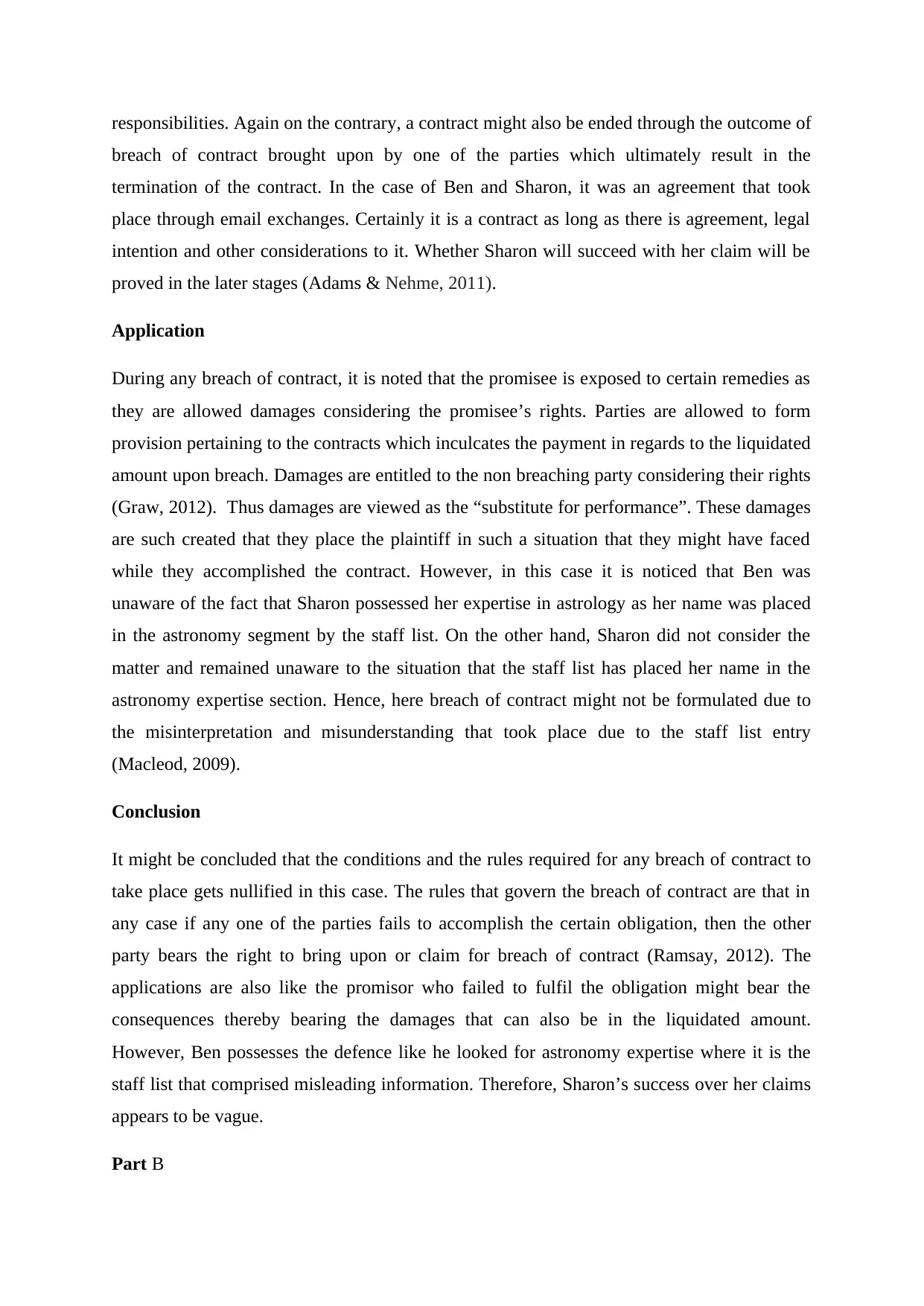
responsibilities. Again on the contrary, a contract might also be ended through the outcome of
breach of contract brought upon by one of the parties which ultimately result in the
termination of the contract. In the case of Ben and Sharon, it was an agreement that took
place through email exchanges. Certainly it is a contract as long as there is agreement, legal
intention and other considerations to it. Whether Sharon will succeed with her claim will be
proved in the later stages (Adams & Nehme, 2011).
Application
During any breach of contract, it is noted that the promisee is exposed to certain remedies as
they are allowed damages considering the promisee’s rights. Parties are allowed to form
provision pertaining to the contracts which inculcates the payment in regards to the liquidated
amount upon breach. Damages are entitled to the non breaching party considering their rights
(Graw, 2012). Thus damages are viewed as the “substitute for performance”. These damages
are such created that they place the plaintiff in such a situation that they might have faced
while they accomplished the contract. However, in this case it is noticed that Ben was
unaware of the fact that Sharon possessed her expertise in astrology as her name was placed
in the astronomy segment by the staff list. On the other hand, Sharon did not consider the
matter and remained unaware to the situation that the staff list has placed her name in the
astronomy expertise section. Hence, here breach of contract might not be formulated due to
the misinterpretation and misunderstanding that took place due to the staff list entry
(Macleod, 2009).
Conclusion
It might be concluded that the conditions and the rules required for any breach of contract to
take place gets nullified in this case. The rules that govern the breach of contract are that in
any case if any one of the parties fails to accomplish the certain obligation, then the other
party bears the right to bring upon or claim for breach of contract (Ramsay, 2012). The
applications are also like the promisor who failed to fulfil the obligation might bear the
consequences thereby bearing the damages that can also be in the liquidated amount.
However, Ben possesses the defence like he looked for astronomy expertise where it is the
staff list that comprised misleading information. Therefore, Sharon’s success over her claims
appears to be vague.
Part B
breach of contract brought upon by one of the parties which ultimately result in the
termination of the contract. In the case of Ben and Sharon, it was an agreement that took
place through email exchanges. Certainly it is a contract as long as there is agreement, legal
intention and other considerations to it. Whether Sharon will succeed with her claim will be
proved in the later stages (Adams & Nehme, 2011).
Application
During any breach of contract, it is noted that the promisee is exposed to certain remedies as
they are allowed damages considering the promisee’s rights. Parties are allowed to form
provision pertaining to the contracts which inculcates the payment in regards to the liquidated
amount upon breach. Damages are entitled to the non breaching party considering their rights
(Graw, 2012). Thus damages are viewed as the “substitute for performance”. These damages
are such created that they place the plaintiff in such a situation that they might have faced
while they accomplished the contract. However, in this case it is noticed that Ben was
unaware of the fact that Sharon possessed her expertise in astrology as her name was placed
in the astronomy segment by the staff list. On the other hand, Sharon did not consider the
matter and remained unaware to the situation that the staff list has placed her name in the
astronomy expertise section. Hence, here breach of contract might not be formulated due to
the misinterpretation and misunderstanding that took place due to the staff list entry
(Macleod, 2009).
Conclusion
It might be concluded that the conditions and the rules required for any breach of contract to
take place gets nullified in this case. The rules that govern the breach of contract are that in
any case if any one of the parties fails to accomplish the certain obligation, then the other
party bears the right to bring upon or claim for breach of contract (Ramsay, 2012). The
applications are also like the promisor who failed to fulfil the obligation might bear the
consequences thereby bearing the damages that can also be in the liquidated amount.
However, Ben possesses the defence like he looked for astronomy expertise where it is the
staff list that comprised misleading information. Therefore, Sharon’s success over her claims
appears to be vague.
Part B
Paraphrase This Document
Need a fresh take? Get an instant paraphrase of this document with our AI Paraphraser
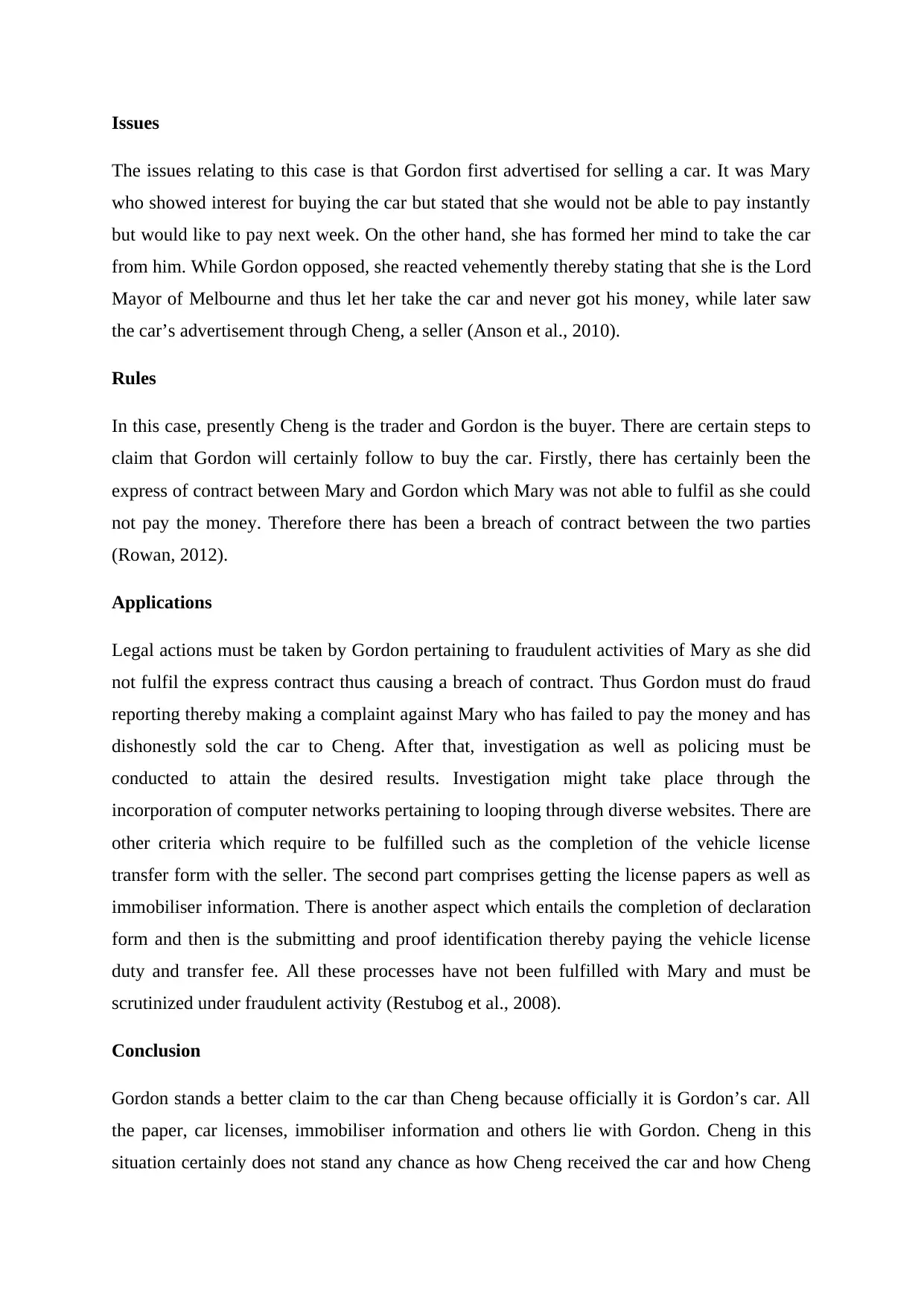
Issues
The issues relating to this case is that Gordon first advertised for selling a car. It was Mary
who showed interest for buying the car but stated that she would not be able to pay instantly
but would like to pay next week. On the other hand, she has formed her mind to take the car
from him. While Gordon opposed, she reacted vehemently thereby stating that she is the Lord
Mayor of Melbourne and thus let her take the car and never got his money, while later saw
the car’s advertisement through Cheng, a seller (Anson et al., 2010).
Rules
In this case, presently Cheng is the trader and Gordon is the buyer. There are certain steps to
claim that Gordon will certainly follow to buy the car. Firstly, there has certainly been the
express of contract between Mary and Gordon which Mary was not able to fulfil as she could
not pay the money. Therefore there has been a breach of contract between the two parties
(Rowan, 2012).
Applications
Legal actions must be taken by Gordon pertaining to fraudulent activities of Mary as she did
not fulfil the express contract thus causing a breach of contract. Thus Gordon must do fraud
reporting thereby making a complaint against Mary who has failed to pay the money and has
dishonestly sold the car to Cheng. After that, investigation as well as policing must be
conducted to attain the desired results. Investigation might take place through the
incorporation of computer networks pertaining to looping through diverse websites. There are
other criteria which require to be fulfilled such as the completion of the vehicle license
transfer form with the seller. The second part comprises getting the license papers as well as
immobiliser information. There is another aspect which entails the completion of declaration
form and then is the submitting and proof identification thereby paying the vehicle license
duty and transfer fee. All these processes have not been fulfilled with Mary and must be
scrutinized under fraudulent activity (Restubog et al., 2008).
Conclusion
Gordon stands a better claim to the car than Cheng because officially it is Gordon’s car. All
the paper, car licenses, immobiliser information and others lie with Gordon. Cheng in this
situation certainly does not stand any chance as how Cheng received the car and how Cheng
The issues relating to this case is that Gordon first advertised for selling a car. It was Mary
who showed interest for buying the car but stated that she would not be able to pay instantly
but would like to pay next week. On the other hand, she has formed her mind to take the car
from him. While Gordon opposed, she reacted vehemently thereby stating that she is the Lord
Mayor of Melbourne and thus let her take the car and never got his money, while later saw
the car’s advertisement through Cheng, a seller (Anson et al., 2010).
Rules
In this case, presently Cheng is the trader and Gordon is the buyer. There are certain steps to
claim that Gordon will certainly follow to buy the car. Firstly, there has certainly been the
express of contract between Mary and Gordon which Mary was not able to fulfil as she could
not pay the money. Therefore there has been a breach of contract between the two parties
(Rowan, 2012).
Applications
Legal actions must be taken by Gordon pertaining to fraudulent activities of Mary as she did
not fulfil the express contract thus causing a breach of contract. Thus Gordon must do fraud
reporting thereby making a complaint against Mary who has failed to pay the money and has
dishonestly sold the car to Cheng. After that, investigation as well as policing must be
conducted to attain the desired results. Investigation might take place through the
incorporation of computer networks pertaining to looping through diverse websites. There are
other criteria which require to be fulfilled such as the completion of the vehicle license
transfer form with the seller. The second part comprises getting the license papers as well as
immobiliser information. There is another aspect which entails the completion of declaration
form and then is the submitting and proof identification thereby paying the vehicle license
duty and transfer fee. All these processes have not been fulfilled with Mary and must be
scrutinized under fraudulent activity (Restubog et al., 2008).
Conclusion
Gordon stands a better claim to the car than Cheng because officially it is Gordon’s car. All
the paper, car licenses, immobiliser information and others lie with Gordon. Cheng in this
situation certainly does not stand any chance as how Cheng received the car and how Cheng

fulfilled the buying process pertaining to legal paper works of the car appears to be a big
question (McKendrick, 2014).
question (McKendrick, 2014).
⊘ This is a preview!⊘
Do you want full access?
Subscribe today to unlock all pages.

Trusted by 1+ million students worldwide
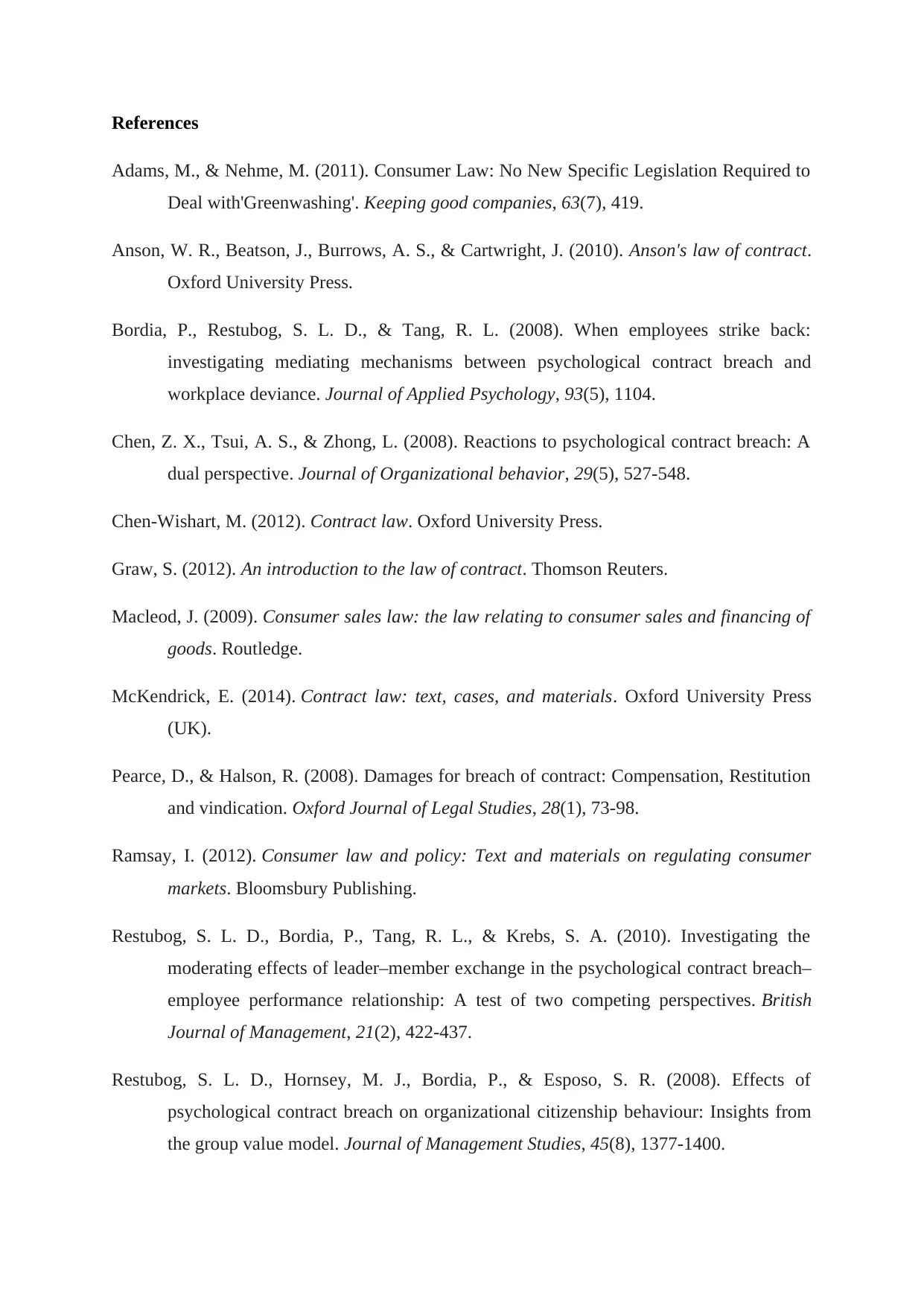
References
Adams, M., & Nehme, M. (2011). Consumer Law: No New Specific Legislation Required to
Deal with'Greenwashing'. Keeping good companies, 63(7), 419.
Anson, W. R., Beatson, J., Burrows, A. S., & Cartwright, J. (2010). Anson's law of contract.
Oxford University Press.
Bordia, P., Restubog, S. L. D., & Tang, R. L. (2008). When employees strike back:
investigating mediating mechanisms between psychological contract breach and
workplace deviance. Journal of Applied Psychology, 93(5), 1104.
Chen, Z. X., Tsui, A. S., & Zhong, L. (2008). Reactions to psychological contract breach: A
dual perspective. Journal of Organizational behavior, 29(5), 527-548.
Chen-Wishart, M. (2012). Contract law. Oxford University Press.
Graw, S. (2012). An introduction to the law of contract. Thomson Reuters.
Macleod, J. (2009). Consumer sales law: the law relating to consumer sales and financing of
goods. Routledge.
McKendrick, E. (2014). Contract law: text, cases, and materials. Oxford University Press
(UK).
Pearce, D., & Halson, R. (2008). Damages for breach of contract: Compensation, Restitution
and vindication. Oxford Journal of Legal Studies, 28(1), 73-98.
Ramsay, I. (2012). Consumer law and policy: Text and materials on regulating consumer
markets. Bloomsbury Publishing.
Restubog, S. L. D., Bordia, P., Tang, R. L., & Krebs, S. A. (2010). Investigating the
moderating effects of leader–member exchange in the psychological contract breach–
employee performance relationship: A test of two competing perspectives. British
Journal of Management, 21(2), 422-437.
Restubog, S. L. D., Hornsey, M. J., Bordia, P., & Esposo, S. R. (2008). Effects of
psychological contract breach on organizational citizenship behaviour: Insights from
the group value model. Journal of Management Studies, 45(8), 1377-1400.
Adams, M., & Nehme, M. (2011). Consumer Law: No New Specific Legislation Required to
Deal with'Greenwashing'. Keeping good companies, 63(7), 419.
Anson, W. R., Beatson, J., Burrows, A. S., & Cartwright, J. (2010). Anson's law of contract.
Oxford University Press.
Bordia, P., Restubog, S. L. D., & Tang, R. L. (2008). When employees strike back:
investigating mediating mechanisms between psychological contract breach and
workplace deviance. Journal of Applied Psychology, 93(5), 1104.
Chen, Z. X., Tsui, A. S., & Zhong, L. (2008). Reactions to psychological contract breach: A
dual perspective. Journal of Organizational behavior, 29(5), 527-548.
Chen-Wishart, M. (2012). Contract law. Oxford University Press.
Graw, S. (2012). An introduction to the law of contract. Thomson Reuters.
Macleod, J. (2009). Consumer sales law: the law relating to consumer sales and financing of
goods. Routledge.
McKendrick, E. (2014). Contract law: text, cases, and materials. Oxford University Press
(UK).
Pearce, D., & Halson, R. (2008). Damages for breach of contract: Compensation, Restitution
and vindication. Oxford Journal of Legal Studies, 28(1), 73-98.
Ramsay, I. (2012). Consumer law and policy: Text and materials on regulating consumer
markets. Bloomsbury Publishing.
Restubog, S. L. D., Bordia, P., Tang, R. L., & Krebs, S. A. (2010). Investigating the
moderating effects of leader–member exchange in the psychological contract breach–
employee performance relationship: A test of two competing perspectives. British
Journal of Management, 21(2), 422-437.
Restubog, S. L. D., Hornsey, M. J., Bordia, P., & Esposo, S. R. (2008). Effects of
psychological contract breach on organizational citizenship behaviour: Insights from
the group value model. Journal of Management Studies, 45(8), 1377-1400.
Paraphrase This Document
Need a fresh take? Get an instant paraphrase of this document with our AI Paraphraser
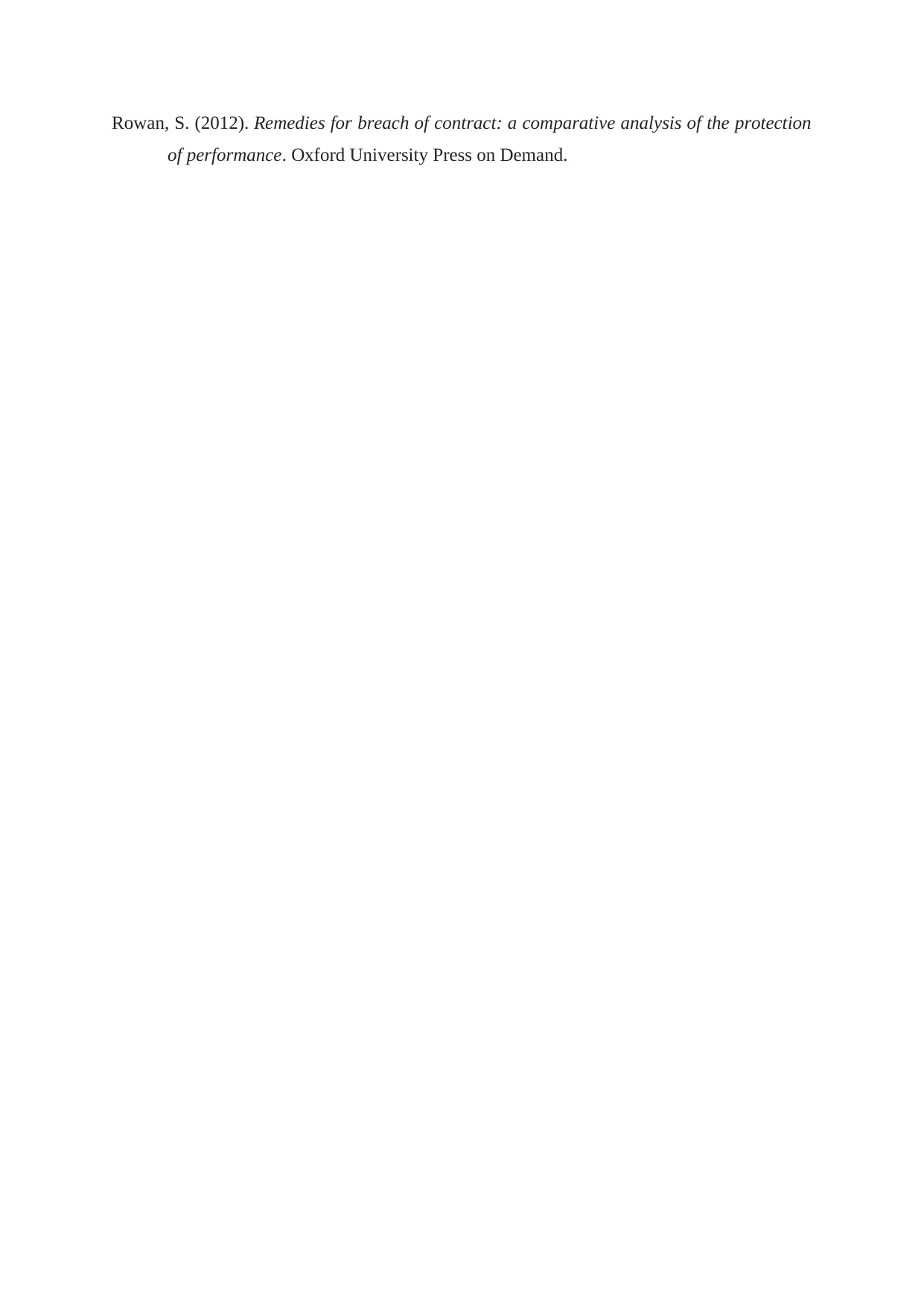
Rowan, S. (2012). Remedies for breach of contract: a comparative analysis of the protection
of performance. Oxford University Press on Demand.
of performance. Oxford University Press on Demand.
1 out of 8
Your All-in-One AI-Powered Toolkit for Academic Success.
+13062052269
info@desklib.com
Available 24*7 on WhatsApp / Email
![[object Object]](/_next/static/media/star-bottom.7253800d.svg)
Unlock your academic potential
Copyright © 2020–2025 A2Z Services. All Rights Reserved. Developed and managed by ZUCOL.